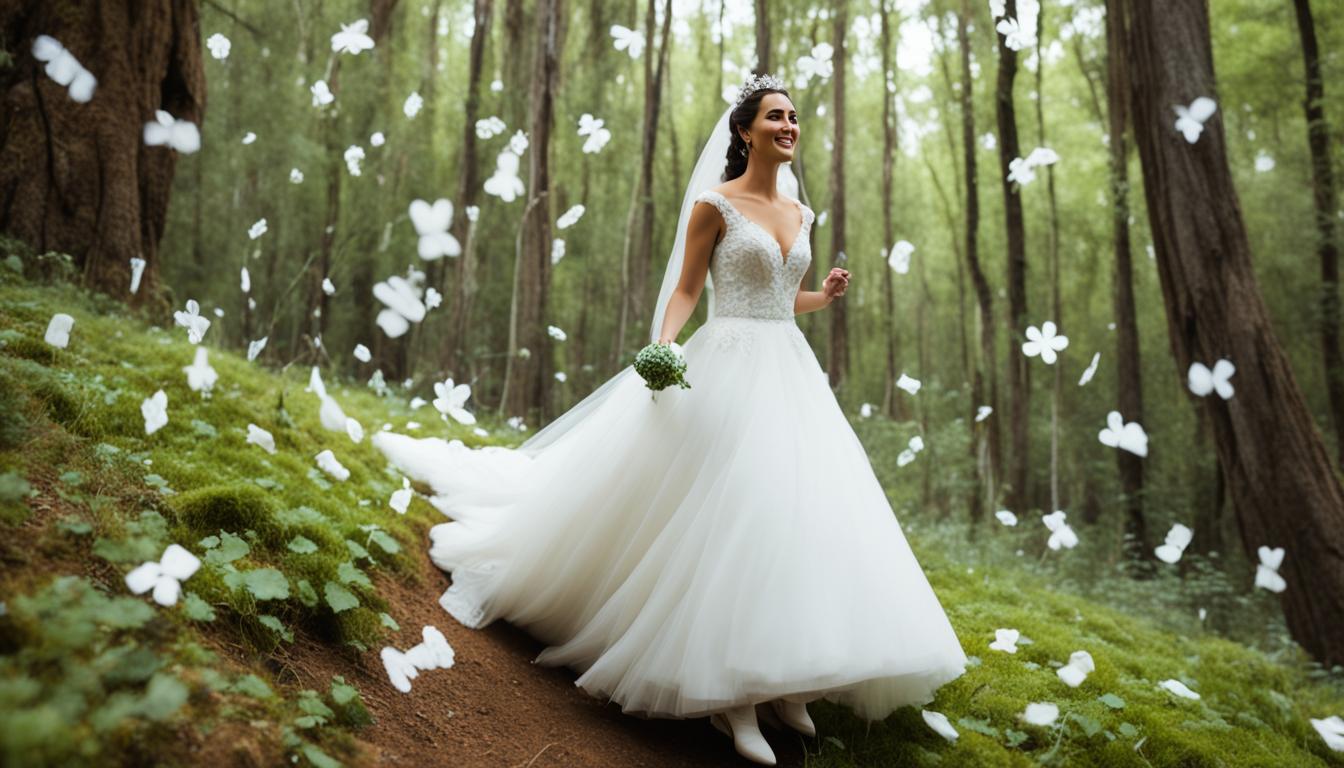Originally posted on January 24, 2024 @ 8:08 am
Weddings are full of traditions and superstitions, many of which have been passed down through generations. One well-known superstition revolves around the wedding dress – the belief that it is bad luck to show it before the ceremony. But where does this superstition come from, and is there any truth to it?
Historically, the tradition of not showing the wedding dress before the ceremony can be traced back to the era of arranged marriages. In those times, the bride and groom were not allowed to see each other until the wedding day. This was done to prevent the possibility of the groom backing out of the marriage if he found the bride unattractive.
While arranged marriages are no longer common, the superstition of not revealing the wedding dress before the big day still persists in many weddings. Some couples believe that it adds an element of surprise and excitement to the ceremony, while others adhere to it out of respect for tradition.
Key Takeaways:
- The tradition of not showing the wedding dress before the ceremony originated from the era of arranged marriages.
- It was believed that if the groom saw the bride before the wedding and found her unattractive, he might call off the marriage.
- While the superstition continues today, some couples choose to show the dress before the ceremony, breaking away from tradition.
- Ultimately, whether to show the dress or not is a personal decision for each couple.
- The most important thing is that the couple feels happy and comfortable with their choices on their special day.
The Origin of This Tradition
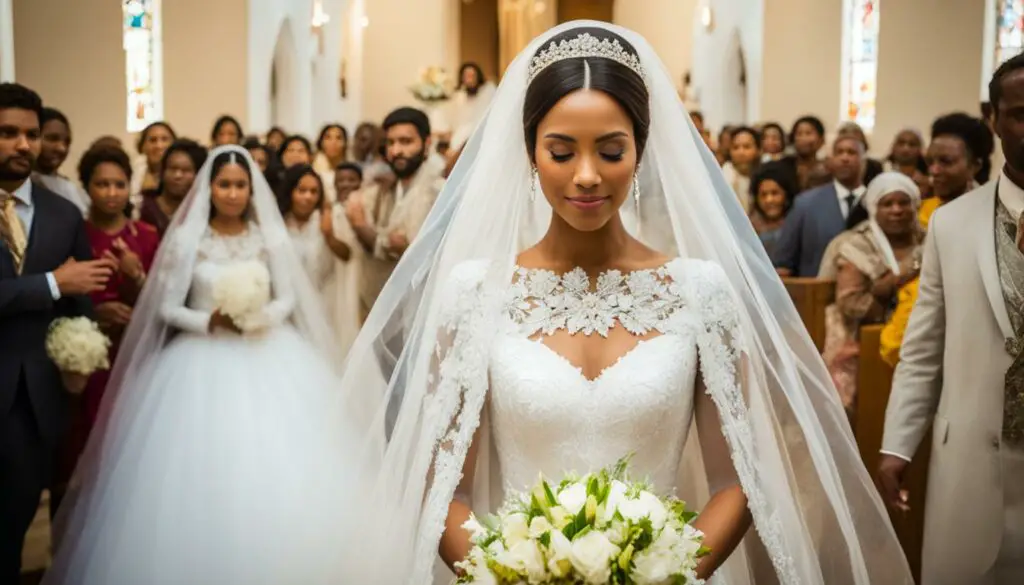
The tradition of not showing the wedding dress to the groom before the ceremony has a fascinating origin rooted in the historical context of arranged marriages. During a time when arranged marriages were prevalent, it was believed that if the groom saw the bride before the wedding and found her unattractive, he might call off the wedding, bringing shame to the bride and her family.
To prevent this potential outcome, a precautionary measure was put in place – the bride and groom were only allowed to meet at the wedding ceremony itself. This tradition aimed to ensure that the groom’s perception of the bride was not solely based on her physical appearance, but also encompassed the emotional connection established during the marital union.
The practice of veiling the bride also played a crucial role in this tradition. As the bride walked down the aisle, the veil served as a barrier, preventing the groom from seeing her face until the last moment. This element of surprise added an extra layer of anticipation and excitement to the wedding ceremony.
Over time, this tradition has evolved, and while arranged marriages are no longer as prevalent, the superstition of not showing the wedding dress to the groom before the ceremony still persists in many weddings. Couples often choose to uphold this custom to honor the historical significance behind it and to preserve the element of surprise on their special day.
Modern Perspectives on Showing the Wedding Dress to the Groom
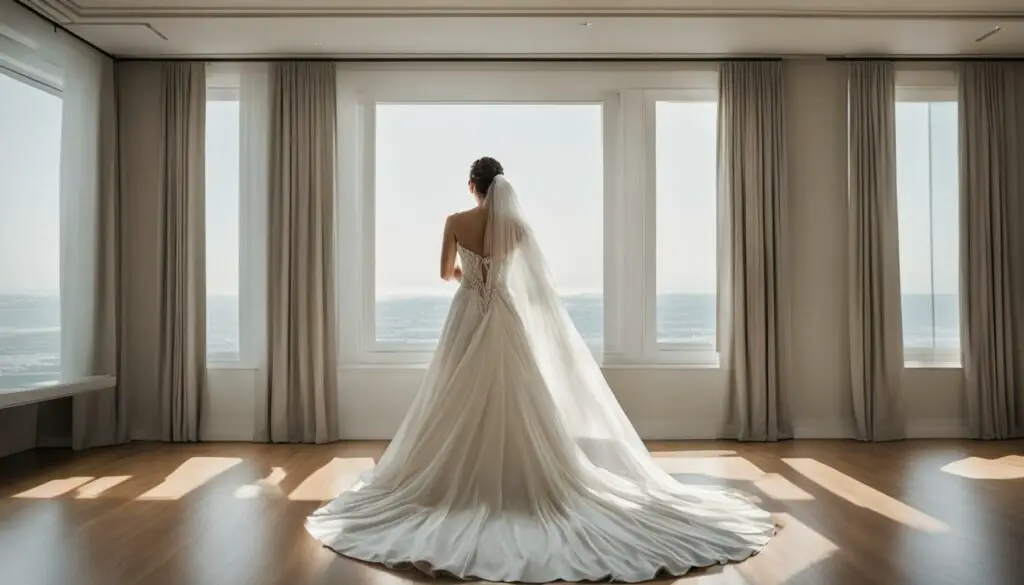
While many couples still adhere to the tradition of not showing the wedding dress to the groom before the ceremony, modern perspectives on this matter are diverse. Some couples believe that seeing each other before the wedding adds excitement and makes the day more memorable. They see it as an opportunity to share an intimate moment and build anticipation together.
Conversely, there are couples who prefer to maintain the element of surprise and tradition by refraining from showing the dress before the ceremony. To them, the moment the groom lays eyes on the bride walking down the aisle is filled with awe and emotion. It symbolizes the start of a new chapter in their lives, and they want to hold onto the tradition and suspense.
Additionally, some couples choose to have a private reveal before the ceremony, where they can have a few moments together to calm nerves and share their excitement. This intimate and personal moment allows them to enjoy each other’s company and provide support before the wedding festivities begin.
Ultimately, the decision of whether to show the wedding dress before the ceremony is a personal one for each couple. It depends on their individual preferences, beliefs, and the significance they attach to tradition versus creating unique experiences. Whatever their choice may be, the most important aspect is that the couple feels happy, comfortable, and aligned with their decision on their special day.
The Tradition of Something Old, Something New, Something Borrowed, Something Blue
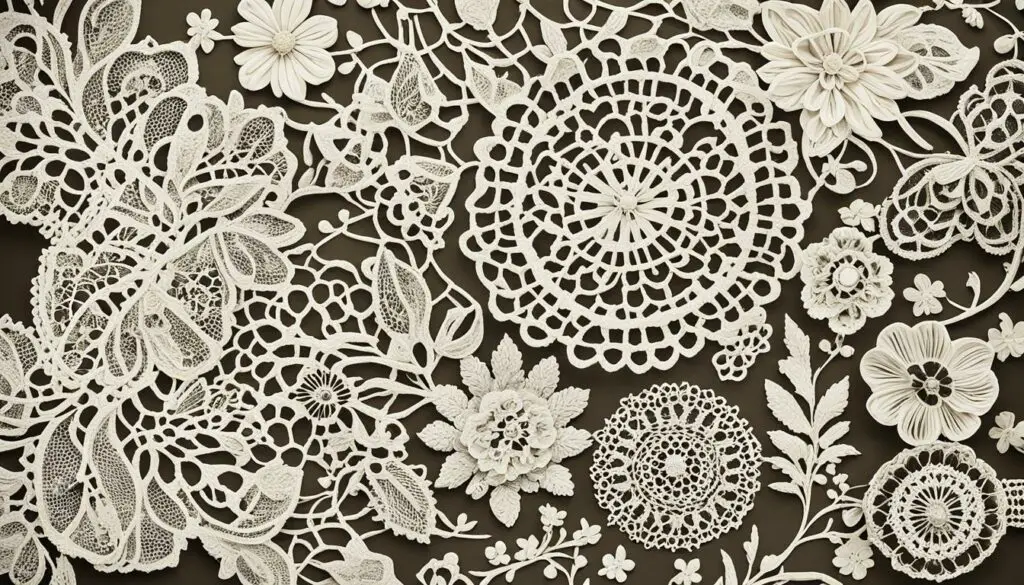
The tradition of wearing something old, something new, something borrowed, and something blue is a time-honored custom that is believed to bring good luck to the bride. This tradition dates back to Victorian times and is still commonly practiced today.
The “something old” represents the couple’s connection with their families. It is often an heirloom piece, such as a vintage piece of jewelry or a family heirloom that holds sentimental value. This symbolizes the bride’s roots and the continuation of family traditions.
The “something new” represents the start of a new chapter in the couple’s lives. It can be something the bride purchases specifically for her wedding day, such as a new dress, shoes, or accessories. This symbolizes hope, optimism, and the exciting journey ahead for the couple.
The “something borrowed” holds special meaning as it is a token of love from a friend or family member. It could be an item borrowed from a happily married friend, a family member’s cherished accessory, or even an old wedding day item from a loved one. This borrowed item is believed to bring the couple good luck and happiness in their marriage.
The “something blue” symbolizes fidelity and loyalty in the marriage. It can be incorporated into the bride’s attire through a blue garter, blue ribbon, blue stitching on the wedding dress, or even blue jewelry. This tradition stems from ancient times when blue was considered a color that protected against evil spirits and symbolized loyalty and faithfulness.
The tradition of something old, something new, something borrowed, something blue adds a touch of sentimentality and symbolism to a wedding day. It allows the bride to honor her family, embrace new beginnings, and bring good luck to her marriage. While the items themselves may seem small, they hold great significance in creating a memorable and meaningful wedding day.
The Origins of the Bouquet and Garter Toss

The tradition of tossing the bride’s bouquet and the groom’s garter has its origins in medieval times. It was believed to bring good luck for guests to get a piece of the bride’s clothing, so they would follow the couple into the wedding chamber and try to tear off pieces of the bride’s gown. To distract the guests, the bride began tossing her bouquet while she and the groom made their getaway. The groom would then toss the garter to the crowd as a way of announcing that he was about to “seal the deal.”
“Guests would follow the couple into the wedding chamber and try to tear pieces of the bride’s gown.”
The bouquet and garter toss has evolved over time and now serves as a fun tradition during the wedding reception. The single women attending the wedding compete to catch the bouquet, believing that the one who catches it will be the next to get married. Likewise, the single men avidly participate in the garter toss, hoping to be the lucky one to catch the bride’s garter.
While these customs might seem a bit peculiar in today’s weddings, they are a playful nod to the past and add an element of excitement and tradition to the celebration. Now let’s take a look at some other intriguing wedding customs that have stood the test of time.
Origins of Wedding Customs
| Wedding Custom | Origin |
|---|---|
| Bouquet Toss | Medieval times – Guests trying to get a piece of the bride’s gown |
| Garter Toss | Medieval times – Announcing the groom’s intention to “seal the deal” |
| Something Old, Something New | Victorian era – Symbolizing connections with the past and a fresh start |
| Carrying the Bride Over the Threshold | Ancient cultures – Protection from evil spirits and bad luck |
| Saving the Top Layer of the Wedding Cake | Connecting weddings and christenings – Symbolic for the first anniversary |
Saving the Top Layer of the Wedding Cake
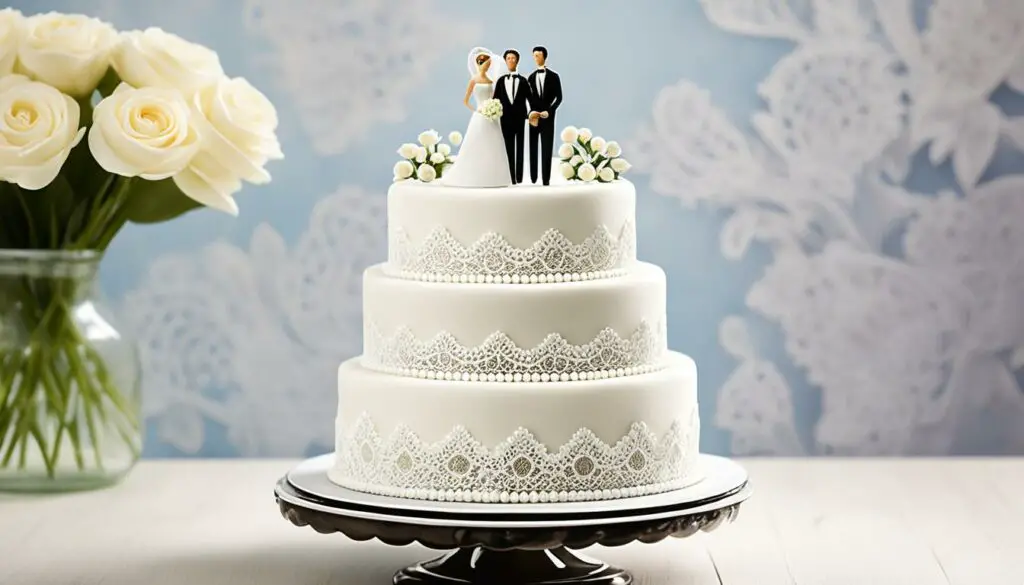
The tradition of saving the top layer of the wedding cake holds significant meaning and has its origins in an age-old custom. In the past, weddings and christenings were often linked, as it was believed that once a wedding took place, a baby would soon follow. To symbolize this connection, couples started saving the top layer of the wedding cake for the christening ceremony.
As the popularity of multi-tiered wedding cakes grew, the tradition of saving the top layer evolved. Today, couples choose to save the top layer of their wedding cake to enjoy on their first anniversary as a special reminder of their wedding day.
The act of saving the top layer of the wedding cake carries sentimental value and serves as a cherished symbol of love and commitment. It allows couples to relive the joy and happiness they experienced on their wedding day, celebrating their journey together as they savor the delicious flavors of the cake. It is a sweet tradition that adds a touch of nostalgia and romance to future anniversary celebrations.
The Threshold Tradition

The tradition of carrying the bride over the threshold has been a long-standing custom in various cultures. This ritual holds symbolic meaning and is associated with the bride’s transition into her new home with her husband. The origins of this tradition can be traced back to different historical beliefs and practices.
Medieval Europe: Avoiding Scandal
In medieval Europe, it was considered scandalous for a woman to display enthusiasm about losing her virginity. To avoid any appearance of immodesty or eagerness, the groom would carry the bride over the threshold of their new home. This act was meant to preserve the bride’s modesty and uphold societal expectations surrounding female purity.
Preventing Mishaps and Bad Luck
In Western European cultures, there was a belief that if a bride stumbled or tripped while entering her new home, it would bring bad luck to the marriage. To prevent any mishaps and ensure a smooth transition into married life, the groom would carry the bride over the threshold. This gesture was seen as protective and a way to ward off any potential negative influences on the couple’s union.
Protecting Against Evil Spirits
Ancient cultures viewed doorways and thresholds as liminal spaces where good and evil spirits coexisted. It was believed that evil spirits could enter the home through the threshold, endangering the bride and the marriage. To safeguard the bride from such spirits, the groom would carry her across the threshold, symbolically protecting her from any harm and ensuring a harmonious start to their life together.
The tradition of carrying the bride over the threshold has persisted through the centuries, although its meaning and significance may vary across different cultures and contexts. Today, while some couples choose to honor this tradition as a symbolic gesture of love and protection, others may opt for alternative ways to symbolize their union.
Overall, the threshold tradition highlights the importance of the bride’s transition into her new home and the groom’s role as her protector. It adds a touch of romance and symbolism to the beginning of their shared journey as a married couple.
Wedding Superstitions: Rain on Your Wedding Day and More
Weddings are full of superstitions and old wives’ tales that have been passed down through generations. These beliefs add an air of mystery and excitement to the big day. One well-known wedding superstition is the belief that rain on the wedding day is a sign of good luck and fertility. While rain might be seen as an inconvenience for some, it is believed to symbolize blessings and abundance in marriage.
“Rain on your wedding day is a sign of fertility and cleansing of the past. It is also believed to bring unity and a fresh start to the couple’s new life together,” says wedding planner Emma Thompson.
Another wedding superstition that may surprise some is the belief that crying on the wedding day is actually considered good luck. It is believed that shedding tears on the wedding day ensures that the couple will have a happy and tear-free marriage. So, if you find yourself getting emotional during your vows or during a heartfelt toast, don’t worry, it’s a sign of good luck!
Some other wedding superstitions include:
- Dropping the rings during the ceremony is thought to bring bad luck. To avoid this, many couples opt for a ring bearer or a secure ring box.
- Catching the bride’s bouquet is believed to predict who will be the next person to get married. This often leads to a lively gathering of single ladies vying to catch the bouquet and claim the title of the next bride-to-be.
“Many brides still believe in these wedding superstitions and incorporate them into their special day. It adds an element of fun and tradition to the celebration,”
says wedding historian Sarah Johnson.
In conclusion, wedding superstitions are a fascinating part of the wedding folklore. From rain on the wedding day to catching the bouquet, these age-old beliefs continue to shape the way couples celebrate their special day. Whether you choose to embrace these superstitions or not, what matters most is that your wedding day is filled with love, joy, and memorable moments.
Conclusion
Wedding dress superstitions and traditions have been rooted in historical customs and beliefs, but they have evolved over time to become personal choices for each couple. While many couples still adhere to these traditions, there are no hard and fast rules when it comes to showing the wedding dress before the ceremony. Debunking wedding traditions is about embracing the freedom to create a wedding experience that feels authentic and meaningful to the couple.
Weddings are a celebration of love, and the most important thing is that the couple feels happy and comfortable with their choices on their special day. Whether it’s about showing the wedding dress, incorporating something old, something new, something borrowed, something blue, or participating in the bouquet and garter toss, the meaning behind these traditions lies in the significance they hold for the couple. It is debunking the notion that following these traditions guarantees good or bad luck.
Modern perspectives on weddings have allowed couples to break free from traditional expectations and create their own unique celebrations. Some couples choose to show the wedding dress before the ceremony as a way to share the excitement and joy with their partner, while others prefer to keep it a surprise. The decision on whether to follow these traditions or debunk them ultimately rests with the couple, as their feelings and desires should take precedence over any superstitions or societal norms.
Debunking wedding traditions is about embracing the freedom to create a wedding that reflects the couple’s values and beliefs. Whether it’s debunking the superstition of not showing the wedding dress or challenging other long-standing customs, what matters most is that the couple feels a genuine connection to their wedding day and can create memories that will last a lifetime.
FAQ
Is it bad luck to show your wedding dress before the ceremony?
The belief that it is bad luck to show your wedding dress before the ceremony stems from the tradition of arranged marriages, where the bride and groom were not allowed to see each other until the wedding. While this superstition still persists in some weddings, it ultimately depends on the couple’s personal beliefs and preferences.
What is the origin of the tradition of not showing the wedding dress to the groom?
The tradition of not showing the wedding dress to the groom before the ceremony has its roots in arranged marriages. It was believed that if the groom saw the bride before the wedding and found her unattractive, he might call off the marriage, bringing shame to the bride and her family. This tradition was a way to prevent that from happening.
What are modern perspectives on showing the wedding dress to the groom?
Modern perspectives vary when it comes to showing the wedding dress to the groom before the ceremony. Some couples believe that seeing each other before the wedding adds excitement and creates more memorable moments. Others opt to have a few minutes together before the ceremony to ease nerves. Ultimately, the decision whether to show the dress or not is a personal one for each couple.
What is the meaning behind “something old, something new, something borrowed, something blue”?
The tradition of wearing “something old, something new, something borrowed, something blue” is believed to bring good luck to the bride. Each item has its own symbolic meaning: “something old” represents the couple’s connection with their families, “something new” signifies the start of a new chapter in their lives, “something borrowed” is a token of love from a friend or family member, and “something blue” symbolizes fidelity.
What is the origin of the bouquet and garter toss?
The tradition of tossing the bride’s bouquet and the groom’s garter dates back to medieval times. It was believed that guests would receive good luck by obtaining a piece of the bride’s clothing. To distract guests from tearing the bride’s gown, she would toss her bouquet while making her getaway with the groom. The groom would then toss the garter to announce his impending marriage.
Why do couples save the top layer of the wedding cake?
The tradition of saving the top layer of the wedding cake originated from the connection between weddings and christenings. In the past, it was believed that a baby would come shortly after a wedding, so the two ceremonies were often linked. As multi-tiered wedding cakes became popular, couples started saving the top layer for the christening. Nowadays, couples save the top layer to enjoy on their first anniversary as a reminder of their special day.
What is the meaning behind carrying the bride over the threshold?
The tradition of the groom carrying the bride over the threshold has various origins. In medieval Europe, it was considered scandalous for a woman to show enthusiasm about losing her virginity, so the groom would carry her to avoid any appearance of eagerness. In Western cultures, tripping over the threshold was believed to bring bad luck to the marriage, so the groom carried the bride to prevent any mishaps. In ancient cultures, the threshold was seen as a place where evil spirits lurked, and carrying the bride inside was meant to protect her from them.
What are some wedding superstitions and their meanings?
Some wedding superstitions include rain on the wedding day being seen as a sign of fertility, cleansing of the past, and unity. Crying on the wedding day is considered good luck, symbolizing shedding all tears and not having any left for the marriage. Dropping the rings during the ceremony is believed to bring bad luck, while catching the bride’s bouquet is thought to predict the next person to get married.
